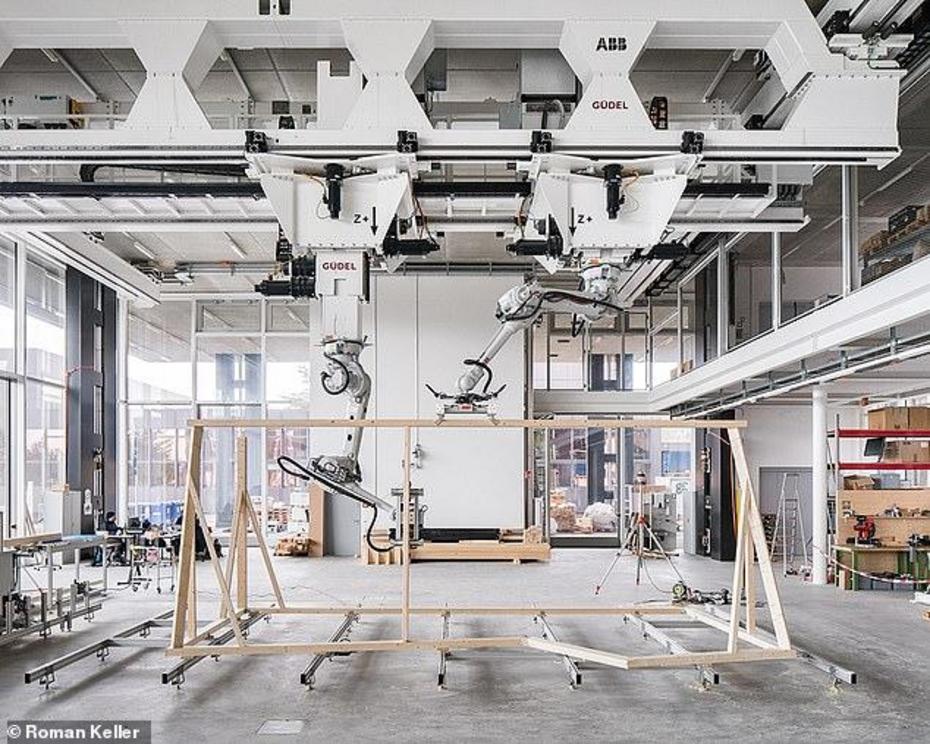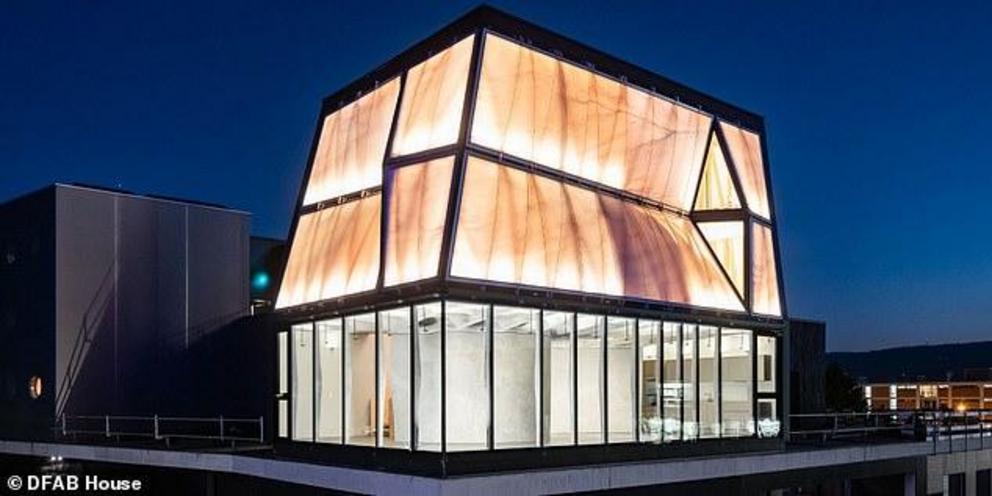The house that robots built: 3D-printed Swiss home constructed by machines is 'the new way of seeing architecture', creators say
- The DFAB House is liveable and created entirely from robot-made materials
- It was built faster and with 60 per cent less cement than a manually built home
- The house passed strict Swiss building standards and is 2,370 square foot
Researchers in Switzerland have built an entire house using robots and 3D-printed materials in what they say is the future of building.
The process turned out to be faster, more environmentally friendly and safer than manual construction.
The DFAB House, built near the capital of Zurich, is the first habitable home to have been made entirely of digital fabrication methods, its creators said.
And the 2,370 square foot (220 square metres) house made it through strict Swiss planning laws and it's hoped it will inspire the future of construction.
 The DFAB House was created using 60 per cent less cement than a normal man-made house, according to its creators
The DFAB House was created using 60 per cent less cement than a normal man-made house, according to its creators
 Robots constructed the house and did it faster and more safely than people could, but the creators don't think people will be made redundant by developments in machinery
Robots constructed the house and did it faster and more safely than people could, but the creators don't think people will be made redundant by developments in machinery
A member of the DFAB team, Matthias Kohler told Quartz: 'This is a new way of seeing architecture.
'Suddenly how we use resources to build our habitats is at the center of architecture. How you build matters.'
The quirky-looking DFAB House used 60 per cent less cement than a traditionally-built home and its ceilings were made with a 3D printer.
The timber frame was constructed on-site by robots and the walls were specially designed to be as energy-efficient as possible.
Although the robots which built the house were able to do so significantly faster than people, the speed gains were secondary to the team's overall goal.
And they said the improvements shouldn't scare people into thinking machines will cut labourers out of their jobs.
Handmade interiors and designs will potentially become even more desirable as building processes are more standardised and control by robots, Mr Kohler suggested.
There will need to be people to operate the robots, too, and working alongside automated machines may be safer than being with other people.
'I think that future machines will be less separated from human,' he said.
'One should not romanticize the jobs on the construction sites. [It] really makes sense to have this kind of collaborative setups where robots and human work together.'
The DFAB House is not the first to have been built by robots.
 The DFAB House is not the first to have been built by machines but, its developers say, it is the first to be inhabitable and made entirely of robot-made components
The DFAB House is not the first to have been built by machines but, its developers say, it is the first to be inhabitable and made entirely of robot-made components
 The timber frame of the house was assembled on-site by machines, but the developers said if this becomes standard they may be more of a call for hand-designed and crafted interiors
The timber frame of the house was assembled on-site by machines, but the developers said if this becomes standard they may be more of a call for hand-designed and crafted interiors
![Matthias Kohler told Quartz: 'One should not romanticize the jobs on the construction sites. [It] really makes sense to have this kind of collaborative setups where robots and human work together'](https://cdn.nexusnewsfeed.com/images/2019/8/18448024-7461315-image-a-27_1568388784759-1568587030568.jpg?w=992&h=744) Matthias Kohler told Quartz: 'One should not romanticize the jobs on the construction sites. [It] really makes sense to have this kind of collaborative setups where robots and human work together'
Matthias Kohler told Quartz: 'One should not romanticize the jobs on the construction sites. [It] really makes sense to have this kind of collaborative setups where robots and human work together'
A Chinese company used 3D printers to build 10 houses in a single day in 2014, followed by an apartment building and mansion the next year, Quartz reported.
And Italian architects last year built one-story home in just 48 hours in a process which they said could could be used to one day build on the moon.
Architects used a 3D concrete printer mounted on a movable base to construct the building, named '3D Housing 05', in Piazza Cesare Beccaria in Milan.
The quick-drying mortar walls set in just 24 hours, significantly faster than the four weeks that traditional concrete takes to dry.
The house was made up of 35 modules that were each printed in 60-90 minutes; meaning the full house was printed in just 48 hours.
Its fixtures and interior decorations were added later by human builders.
WHAT IS 3D PRINTING AND HOW DOES IT WORK?
First invented in the 1980s by Chuck Hull, an engineer and physicist, 3D printing technology – also called additive manufacturing – is the process of making an object by depositing material, one layer at a time.
Similarly to how an inkjet printer adds individual dots of ink to form an image, a 3D printer adds material where it is needed, based on a digital file.
Many conventional manufacturing processes involved cutting away excess materials to make a part, and this can lead to wastage of up to 30 pounds (13.6 kilograms) for every one pound of useful material, according to the Energy Department’s Oak Ridge National Laboratory in Tennessee.
By contrast, with some 3D printing processes about 98 per cent of the raw material is used in the finished part, and the method can be used to make small components using plastics and metal powders, with some experimenting with chocolate and other food, as well as biomaterials similar to human cells.
3D printers have been used to manufacture everything from prosthetic limbs to robots, and the process follows these basic steps:
· Creating a 3D blueprint using computer-aided design (CAD) software
· Preparing the printer, including refilling the raw materials such as plastics, metal powders and binding solutions.
· Initiating the printing process via the machine, which builds the object.
· 3D printing processes can vary, but material extrusion is the most common, and it works like a glue gun: the printing material is heated until it liquefies and is extruded through the print nozzle
· Using information from the digital file, the design is split into two-dimensional cross-sections so the printers knows where to put the material
· The nozzle deposits the polymer in thin layers, often 0.1 millimetre (0.004 inches) thick.
· The polymer rapidly solidifies, bonding to the layer below before the build platform lowers and the print head adds another layer (depending on the object, the entire process can take anywhere from minutes to days.)
· After the printing is finished, every object requires some post-processing, ranging from unsticking the object from the build platform to removing support, to removing excess powders.
